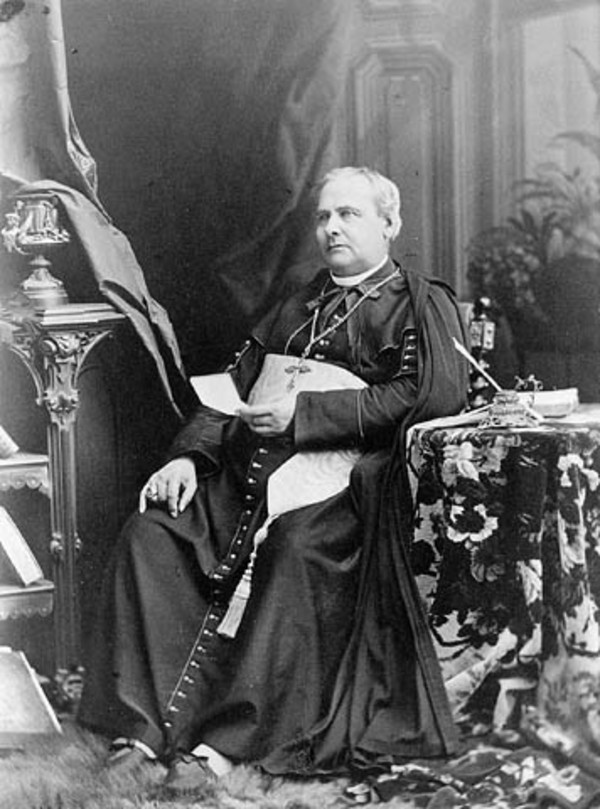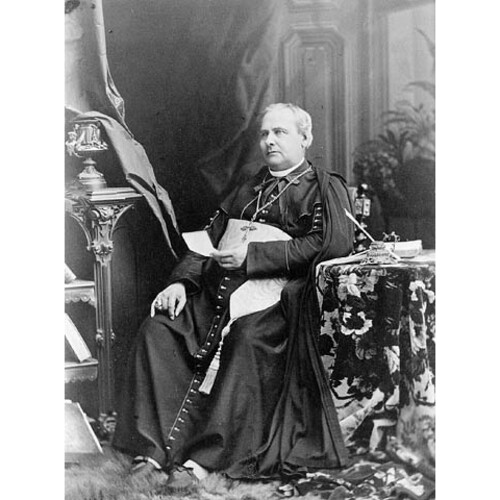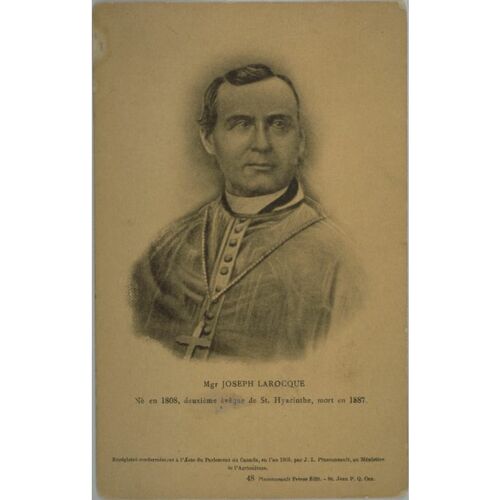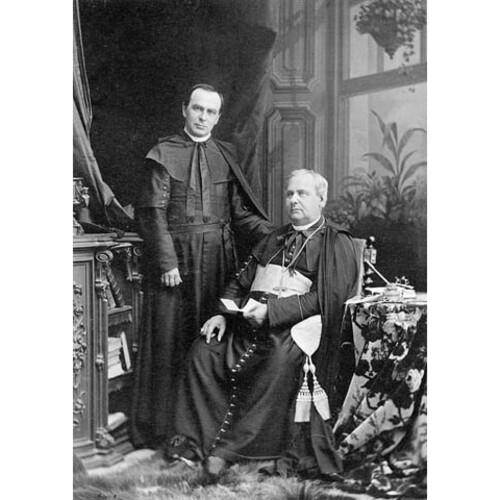LA ROCQUE (Larocque), JOSEPH, Roman Catholic priest, professor, and bishop; b. 28 Aug. 1808 at Chambly, on the Richelieu River, Lower Canada, son of Timothée-Amable La Rocque and Marie-Angèle Paré; d. 18 Nov. 1887 at Saint-Hyacinthe, Que.
Joseph La Rocque obtained a classical education at the Collège de Saint-Hyacinthe, aided, as was his cousin Charles La Rocque*, by a bursary from the Association pour faciliter les moyens d’éducation dans la Rivière-Chambly. From 1821 to 1829 his love of study, sharp intelligence, and sound judgement always put him at the top of his class. Having first completed the philosophy programme, La Rocque, during his final year of the classical programme (Rhetoric) under Abbé Joseph-Sabin Raymond, was asked to replace philosophy instructor Abbé Louis Proulx*, who had unexpectedly been appointed director of the college. “Because of the preparation he put into it, his teaching,” according to that institution’s historian, “was enjoyed and was completely satisfactory.”
La Rocque entered ecclesiastical life in August 1829 and, while studying theology, taught literature at the college either in Saint-Hyacinthe or in his native village. When he returned to the Collège de Saint-Hyacinthe, he taught calligraphy, stenography, and drawing as well as literature. With his friend and former teacher of rhetoric, Raymond, he became involved in a controversy concerning the philosophical basis of certainty, taking the position expounded in France some years earlier by Hugues-Félicité-Robert de La Mennais. A papal condemnation of La Mennais’s propositions abruptly ended a lively debate in which the two friends supported each other with more bluster than reason [see Isaac-Stanislas Lesieur-Désaulniers*].
Ordained priest on 15 March 1835 by Bishop Jean-Jacques Lartigue*, La Rocque continued to teach at the Collège de Saint-Hyacinthe, with abbés Raymond, Lesieur-Désaulniers, and Jean-Charles Prince*. He was appointed director on 22 July 1840, and superior two years later when Bishop Ignace Bourget changed the college to a seminary by canonical decree.
In August 1847 Bishop Bourget summoned him to the diocese of Montreal to receive the office of canon in the cathedral chapter. In particular, La Rocque was given the task of editing the Mélanges religieux, succeeding Hector-Louis Langevin* when he resigned on 20 July 1849. The Mélanges was the official organ of the diocese and at the bishopric people thought that during his two years as editor Langevin had given the journal a marked political bias; this bias was to be emphasized again in the political column for which Langevin was asked to be responsible after his resignation. “Since the Mélanges now has a more ecclesiastical character,” La Rocque wrote to him on 1 Oct. 1849, “it would appear that as far as possible it should avoid making an assault upon men’s passions. . . . I believe you will draw the same conclusion, if you recall how unwelcome priests are when they want to give advice to political partisans.” The peace-loving La Rocque, with the collaboration on the paper until December 1849 of Abbé Joseph-François Cénas (a native of Lyons), was obliged despite his inclinations to take up the cudgels against L’Avenir; the latter had mounted a scathing attack on the tithe system and, in general, on the clergy’s influence, which the Rouges deemed excessive in both politics and education. La Rocque’s toughest adversaries were Louis-Antoine Dessaulles* and Joseph Doutre. In September 1851 La Rocque was happy to hand over his position to François-Magloire Derome*, a lawyer. A reluctant journalist, La Rocque was certainly more at ease as spiritual director of the nuns of Notre-Dame de Charité du Bon-Pasteur and the Sisters of Charity of Providence (Sisters of Providence) who were entrusted to his care.
La Rocque accompanied Bishop Prince as his secretary on a trip to Rome in 1852. When in France briefly, La Rocque saw the famous Henri Lacordaire, and their meeting had some bearing on a proposal to establish a Dominican institution at Saint-Hyacinthe. On 6 July 1852, in Rome, Pius IX appointed La Rocque bishop of Cydonia in partibus infidelium and coadjutor in Montreal to succeed Bishop Prince, who had been named on 8 June to the new diocese of Saint-Hyacinthe. On his return home, La Rocque was consecrated bishop on 28 October in the church of his native parish. Not content to devote all his energies to the diocese of Montreal, he also undertook the administration of the diocese of Saint-Hyacinthe from 13 Nov. 1856 to 15 July 1857 during Bishop Prince’s illness. These heavy strains undermined La Rocque’s health, and he began to feel the effect of the disabilities that later forced him to give up his episcopal duties prematurely.
Prince died on 5 May 1860 and La Rocque was his successor, taking possession of the see on 3 September. During his administration of the diocese of Saint-Hyacinthe, six parishes were set up by canonical decree, two new missions were established, and 31 priests were ordained. He visited parishes and missions to ascertain their needs and administer confirmation. Various confraternities were formed, construction was began on the Hôtel-Dieu of Saint-Hyacinthe, and churches and other religious buildings were erected or repaired.
But the bishop’s chief accomplishment, with the help of Vicar General Joseph-Sabin Raymond, was the founding on 14 Sept. 1861 of the order of the Sœurs Adoratrices du Précieux-Sang. In the words of Elphège Gravel, a local ecclesiastic who was to become the first bishop of Nicolet, this foundation was a “work of prayer and expiation in the town of Saint-Hyacinthe,” destined to counterbalance “the sneers and attacks” of the Institut Canadien, whose president at the time by coincidence was an important citizen of Saint-Hyacinthe, Louis-Antoine Dessaulles.
Bishop La Rocque treated this recalcitrant member of his diocese so leniently that he was rather severely reprimanded by Bishop Bourget of Montreal. Dessaulles, held up to public scorn by an “announcement” read from all the Montreal pulpits on 18 Jan. 1863 concerning his lecture at the Institut Canadien on 23 December, was only too happy, in a letter of 1 Feb. 1864 to Bourget, to contrast “the gentleness and spirit of charity, indulgence, and impartiality” of the bishop of Saint-Hyacinthe with the harshness of the bishop of Montreal. He asserted that La Rocque’s comments on his lecture on “progress,” and on his other writings, had singled out neither “the frightful monster of rationalism,” “its hideous head,” or “its poisonous venom,” nor “the blasphemies” of the “tribune of pestilence” that Bishop Bourget had branded as infamous in his “announcement.” La Rocque admitted that this information, transmitted to him the next day by Bishop Bourget, was “a bitter pill” for his spirit, and he sought to exonerate himself in a letter of 3 Feb. 1864. He noted that the “opinion” Dessaulles was quoting as his authority had been “written with extreme moderation of both substance and form.” “Your Excellency,” he continued, “will understand the motive if he reflects on the friendly zeal that makes me desire to see M. Dessaulles return to the principles he acquired in infancy from his devoted mother. But, nevertheless, I certainly have not failed to censure the writer’s rationalist tendencies. It is true that I tell readers I am going to pass quickly over this part of the lecture, as over some other parts. My sole intention has been to smother the fire that had set men’s minds aflame, and to try to restore the peace we desire.”
Bishop La Rocque, in poor health for many years, suffered from sciatica which increasingly confined him to his room; he also had an antipathy to the details of an administration encumbered with a debt of about $44,000, an enormous sum for the period. He begged Pius IX to relieve him of the crushing burden. By a rescript dated 17 Aug. 1865, he was authorized to resign his bishopric and was transferred to the see of Germanicopolis in partibus infidelium. In July the following year he handed over the direction of the diocese to his cousin and successor, Bishop Charles La Rocque, and went to live with the Sœurs Adoratrices du Précieux-Sang.
His retirement was a fruitful one. It enabled him to strengthen the congregation he had founded and to draft its fundamental laws. In addition he was the author of Dévotion au Précieux Sang and of L’Année ecclésiastique et liturgique, a compilation of reflections for Sundays throughout the year and the principal solemn ceremonies of the church; he also wrote a series of meditations for the Retraites annuelles. He celebrated the 50th year of his ordination on 19 March 1885. Two years and eight months later, on 18 Nov. 1887, he died, surrounded by his religious family, at the age of 79. He was buried in the cemetery of the Sœurs Adoratrices du Précieux-Sang.
“Bishop Joseph,” as he was familiarly called by a small circle of close friends, was noted for his shrewd mind, conversational charm, and polished manners. For Louis-Thomas Bourgeois, a French Dominican who had known him at Saint-Hyacinthe, “his generosity and noble mind and spirit made him one of the most likeable of men.”
Joseph La Rocque was the author of L’Année ecclésiastique et liturgique, comprenant toute l’année chrétienne depuis la XXIVe semaine après la Pentecôte jusqu’à la fin de l’année ecclésiastique suivante (Montréal, 1887) and of Dévotion au Précieux Sang, spécialement préparé pour le mois du Précieux Sang (juillet) (4e éd., Saint-Hyacinthe, Qué., 1897).
ACAM, 901.135, 864-1, -2. Mandements, lettres pastorales et circulaires des évêques de Saint-Hyacinthe, A.-X. Bernard, édit. (8v., Montréal, 1888–98), II: 5–16. Mélanges religieux (Montréal), juillet 1849–septembre 1851. E.-J.[-A.] Auclair, Mère Catherine-Aurélie; histoire de mère Catherine-Aurélie du Précieux-Sang, née Aurélie Caouette, fondatrice de l’Institut du Précieux-Sang au Canada, 1833–1905 (Québec, 1923), 422ff. C.-P. Choquette, Histoire du séminaire de Saint-Hyacinthe depuis sa fondation jusqu’à nos jours (2v., Montréal, 1911–12), I. Désilets, Hector-Louis Langevin, 49. Monet, Last cannon shot, 133. A.-J. Plourde, Dominicains au Canada (3v. to date, Montréal, 1973– ), I, no.1. Claude Galarneau, “L’abbé Joseph-Sabin Raymond et les grands romantiques français (1834–1857),” CHA Report, 1963: 85.
Cite This Article
Philippe Sylvain, “LA ROCQUE (Larocque), JOSEPH,” in Dictionary of Canadian Biography, vol. 11, University of Toronto/Université Laval, 2003–, accessed April 25, 2025, https://www.biographi.ca/en/bio/la_rocque_joseph_11E.html.
The citation above shows the format for footnotes and endnotes according to the Chicago manual of style (16th edition). Information to be used in other citation formats:
| Permalink: | https://www.biographi.ca/en/bio/la_rocque_joseph_11E.html |
| Author of Article: | Philippe Sylvain |
| Title of Article: | LA ROCQUE (Larocque), JOSEPH |
| Publication Name: | Dictionary of Canadian Biography, vol. 11 |
| Publisher: | University of Toronto/Université Laval |
| Year of revision: | 1982 |
| Access Date: | April 25, 2025 |






